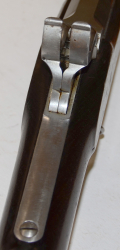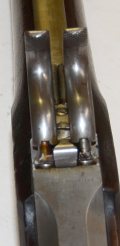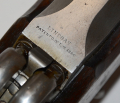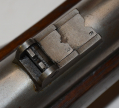site search
online catalog
CONFEDERATE CAPTURED AND COLLECTED LINDSAY TWO-SHOT INFANTRY RIFLE MUSKET

$4,500.00 SOLD
Quantity Available: None
Item Code: 172-5739
This two-shot Lindsay patent rifle-musket is in excellent condition and is significant on three counts. First, the Lindsay is scarce. The government contracted for just 1,000 of them in late 1863. They were received in August 1864 and about half were issued for field trial in September to at least four Union regiments and were used in action. Second, this example bears the stamp of a previously unrecorded Confederate ordnance inspector in the CS cleaning and repair system, corresponding to similar inspection stamps first cataloged by Steve Knott in his 2019 ground-breaking “Captured and Collected” Confederate Reissued Firearms. Lastly, the ampersand (“&”) used by this particular inspector proves that the various letter codes do not, or at least do not necessarily, correspond to the last names of the inspectors.
The Lindsay .58 caliber rifle-musket used superimposed loads in a single barrel with a separate hammer and nipple for each charge. His innovation, patented in 1860 and used in Walch revolvers and Lindsay’s own “Young America” two-shot pistols, was a single trigger that would fire the two rounds in the proper sequence with successive pulls. Ordnance Capt. S.V. Benet reported favorably on tests conducted on the rifle in August 1863, and Lindsay received a contract for 1,000 rifles in December 1863 (after Chief of Ordnance Ripley was replaced.) The rifle followed the general lines of the regulation Springfield and Lindsay contacted with Samuel Norris to produce the majority of the rifle and assemble it, using his patent breech, manufactured by the Union Knife Company, makers of his two-shot pistol. The guns were received in August 1864 and, according to Moller, half were issued in September for field trials to four different regiments: 9th NH, 5th, 16th, and 23rd Michigan. They were used in battle at Peebles Farm, part of the Petersburg Campaign, in October 1864.
This example is in excellent condition, which is not surprising given the limited field use of the guns. The metal is smooth and bright, showing just a few thin gray spots and sharp LINDSAY / PATENT’D OCT. 9. 1860 stamp on the top breech of the barrel just forward of the nipples, and various small inspector initials on the barrel, sight, etc. Both sights are in place. The rear sight may have been blued- there is a little color on the upper left. The rest of the metal is armory bright, as is correct. Swivels, ramrod and bands are in place. The bands follow the Springfield 1863 pattern and dispense with springs, enabling Norris to use the same parts he had used on his 1863 Type-1 rifle muskets, made with W.T. Clement, for Massachusetts.
The stock, of course, was machined differently, eliminating the lock plate, but allowing for the patent breech, trigger mechanism and long tang. The wood retains good color and finish with sharp edges to the two side flats. The wrist is in good shape. The inletting of the lock created a weak spot that sometimes cracks in firing, as a few modern shooters experimenting with it found out. The forestock has very few handling marks. The butt flats show a few dings. The right side flat has a few small nicks to the lower edge, one or two hear the nipple, and a couple of small pressure dents. The left flat has more light scratches and two short deeper ones, but clearly shows two oval cartouches: one mostly in outline at top and another with lettering at the rear.
Most significantly, the stock shows a very clear “&” stamped on the underside just above the triggerguard tang. This joins the letters A,F,Q,T and Z first identified by Steven Knott in 2019 as CS Ordnance inspectors (“Captured and Collected” Confederate Reissued Firearms.) Estimates run as high as 200,000 firearms captured or collected by CS Ordnance teams or civilians and placed into the Confederate cleaning and repair (“C&R”) system for reissue to Confederate troops, along with perhaps another 50,000 turned in by CS units. Most of these were in the eastern theatre, where Confederate victories left battlefields in southern hands, and the guns went through the process at Danville, Staunton, Lynchburg, or Richmond. A few other letters, like a “D” on a weapon we cataloged, expanded the initial list of ordnance inspectors, but collectors and students still looked in vain for CS ordnance officers to match up with them since “Z” paired up well with Capt. Louis Zimmer, supervisor of the C&R system in Richmond in late 1864 to 1865. The ampersand, however, clearly indicates that while the letter codes likely indicate individual ordnance personnel, they need not correspond to the first letter of a last name.
That a Lindsay found its way into Confederate hands in good condition should not be surprising. Field trials were not a success. Main springs and sear springs were reported as weak, and in combat the whole principle would have been questionable: after the first two shots the soldier would be using a rifle that took twice as long to load as a conventional rifle, hardly a reassuring prospect under fire. Even worse, an improperly seated bottom round might discharge from flame leaking from a fired upper round, or a blocked vent to the upper round might leave that powder and ball in place when the trigger was pulled a second time. Lindsay had claimed the lower round could be fired safely even with the upper one in place, but the 16th Michigan, according to Moller, reported rifles destroyed and men killed and injured by exploding rifles. Laying aside one of the rifles unfired and picking up a more conventional arm on the battlefield likely seemed the wisest course of action for a soldier. Those issued to the 9th NH were eventually condemned and turned in.
However misguided in its application, Lindsay’s trigger assembly is a testimony to American mechanical engineering and the rifle merits a place among Civil War infantry longarms actually issued and used in the field. Captain Benet and others thought them worth trying. It would also have been interesting to hear appraisals of them as the latest examples of Yankee ingenuity by Confederate ordnance officers. [sr] [ph:L]
DISCLAIMER: All firearms are sold as collector's items only - we do not accept responsibility as to the shooting safety or reliability of any antique firearm. All firearms are described as accurately as possible, given the restraints of a catalog listing length. We want satisfied customers & often "under" describe the weapons. Any city or state regulations regarding owning antique firearms are the responsibility of the purchaser. All firearms are "mechanically perfect" unless noted, but again, are NOT warranted as safe to fire.
Inquire About CONFEDERATE CAPTURED AND COLLECTED LINDSAY TWO-SHOT INFANTRY RIFLE MUSKET
For inquiries, please email us at [email protected]
Most Popular
Historical Firearms Stolen From The National Civil War Museum In Harrisburg, Pa »
Theft From Gravesite Of Gen. John Reynolds »
Selection Of Unframed Prints By Don Troiani »
Fine Condition Brass Infantry Bugle Insignia »
British Imported, Confederate Used Bayonet »
Scarce New Model 1865 Sharps Still In Percussion Near Factory New »
featured item
ALS, MAJOR GENERAL JAMES LONGSTREET, CSA, Addressed To MAJOR GEN. DANIEL HARVEY HILL
Dated “Hd Qrs June 16th 1862.” One page in ink, 5” x 8. Exhibits fold-marks. Else VG and entirely legible. This letter from one major general divisional commander to was written between between the Battle of Fair Oaks at the end of May 1862 and… (1179-1398). Learn More »
site search
Upcoming Events
May 16 - 18: N-SSA Spring Nationals, Fort Shenandoah, Winchester, VA Learn More »





















